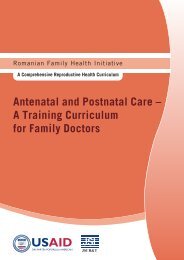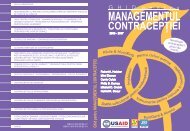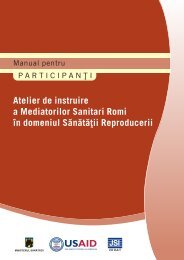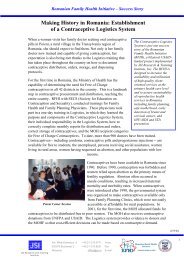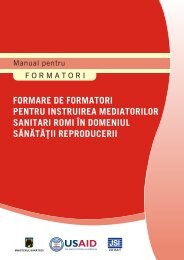Training of Roma Health Mediators in Reproductive Health
Training of Roma Health Mediators in Reproductive Health
Training of Roma Health Mediators in Reproductive Health
You also want an ePaper? Increase the reach of your titles
YUMPU automatically turns print PDFs into web optimized ePapers that Google loves.
• mothers who have difficulty with breastfeed<strong>in</strong>g<br />
• mothers who bottle fed previously but now want to breastfeed<br />
‣ How could a mediator help a mother with breastfeed<strong>in</strong>g?<br />
• Talk with her quietly and with patience<br />
• Ask the mother how she feels and how breastfeed<strong>in</strong>g is go<strong>in</strong>g.<br />
• Try to see the mother when she is feed<strong>in</strong>g her baby, and quietly watch what is<br />
happen<strong>in</strong>g.<br />
• If the mother is hav<strong>in</strong>g difficulty, help her with position<strong>in</strong>g her baby correctly<br />
• Give her relevant <strong>in</strong>formation and make sure that she understands it.<br />
• Answer the mother's questions.<br />
• Expla<strong>in</strong> simply and clearly what she needs to know.<br />
Baby’s position<br />
Expla<strong>in</strong> that position<strong>in</strong>g the baby properly at the breast is necessary so that the baby can<br />
suckle effectively.<br />
Emphasize the follow<strong>in</strong>g po<strong>in</strong>ts when help<strong>in</strong>g mothers:<br />
• Always observe a mother breastfeed<strong>in</strong>g before you help her.<br />
Take time to see what she does, so that you can understand her situation clearly.<br />
Do not rush to make her do someth<strong>in</strong>g different.<br />
• Give a mother help only if she has difficulty.<br />
Some mothers breastfeed babies satisfactorily <strong>in</strong> positions that would be difficult<br />
for others. Do not try to change a baby's position if he is gett<strong>in</strong>g breast milk<br />
effectively and his mother is comfortable.<br />
• Let the mother do as much as possible herself.<br />
Be careful not to `take over' from her. Expla<strong>in</strong> to her what to do. If possible,<br />
demonstrate on your own body to show her what you mean.<br />
• Make sure that she understands what you do so that she can do it herself.<br />
Your aim is to help her to position her own baby. It does not help if you can get a<br />
baby to suckle and his mother cannot.<br />
Inform participants that you will demonstrate, with the help <strong>of</strong> a volunteer, several<br />
techniques and positions for successful breastfeed<strong>in</strong>g, as well as some common mistakes<br />
and how to correct them. Invite them to observe, ask questions and comment as<br />
appropriate.<br />
[Note to the tra<strong>in</strong>er: Before the demonstrations, ask a participant to help you with the<br />
demonstration. Expla<strong>in</strong> that you want her to play the role <strong>of</strong> a mother who needs help to<br />
position her baby. Ask her to decide on a name for herself and her “baby” (the doll). F<strong>in</strong>d<br />
a cloth to cover the table, and some pillows if these are appropriate <strong>in</strong> the community.<br />
Arrange chairs, a footstool, and a bed, or a table that can be used for a bed to demonstrate<br />
breastfeed<strong>in</strong>g ly<strong>in</strong>g down.]<br />
142<br />
RFHI/JSI <strong>Roma</strong>nia <strong>Tra<strong>in</strong><strong>in</strong>g</strong> <strong>of</strong> RHMs <strong>in</strong> <strong>Reproductive</strong> <strong>Health</strong> Session 9: Breastfeed<strong>in</strong>g



